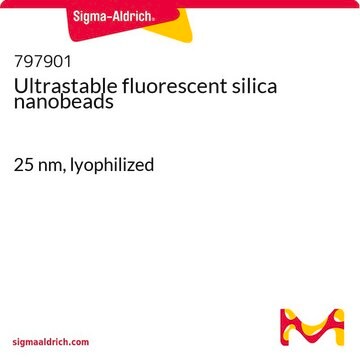637246
Silice
nanopowder (spherical, porous), 5-20 nm particle size (TEM), 99.5% trace metals basis
Sinonimo/i:
Biossido di silicio
About This Item
Prodotti consigliati
Saggio
99.5% trace metals basis
Forma fisica
nanopowder (spherical, porous)
Area superficiale
590-690 m2/g , TEM
Dimensione particelle
5-20 nm (TEM)
P. eboll.
2230 °C (lit.)
Punto di fusione
>1600 °C (lit.)
Densità
2.2-2.6 g/mL at 25 °C
Densità bulk
0.068 g/mL
Stringa SMILE
O=[Si]=O
InChI
1S/O2Si/c1-3-2
VYPSYNLAJGMNEJ-UHFFFAOYSA-N
Cerchi prodotti simili? Visita Guida al confronto tra prodotti
Categorie correlate
Descrizione generale
Applicazioni
- Pickering emulsion polymerization using a silicon dioxide nanoparticle stabilizer to form molecularly imprinted polymers for steroid recognition.
- Mesoporous silica is used as a catalyst support in the preparation of multiwalled carbon nanotubes (MWCNTs).
- It is used as a ring opening of tetrahydrofuran-dimethanol to 1,2,6-hexanetriol.
- It maybe used to prepare silica/brominated poly(phenylene oxide) nanocomposites membranes for CO2 seperations.
- The composite scaffold of chitosan/chondroitin sulfate/nano-SiO2 was fabricated by lyophilization.
- Nanocomposites preparation of silica, single-wall carbon nanotubes, and graphite nanoplatelets in an epoxy matrix have been reported.6
- Dielectric spectroscopy study of the polystyrene/nanosilica model system has been studied.
- PMMA SiO2 nanocomposites were reported to be synthesized.
Codice della classe di stoccaggio
11 - Combustible Solids
Classe di pericolosità dell'acqua (WGK)
nwg
Punto d’infiammabilità (°F)
Not applicable
Punto d’infiammabilità (°C)
Not applicable
Dispositivi di protezione individuale
dust mask type N95 (US), Eyeshields, Gloves
Certificati d'analisi (COA)
Cerca il Certificati d'analisi (COA) digitando il numero di lotto/batch corrispondente. I numeri di lotto o di batch sono stampati sull'etichetta dei prodotti dopo la parola ‘Lotto’ o ‘Batch’.
Possiedi già questo prodotto?
I documenti relativi ai prodotti acquistati recentemente sono disponibili nell’Archivio dei documenti.
I clienti hanno visto anche
Articoli
Review the potential of self-assembled multilayer gate dielectric films fabricated from silane precursors for organic, inorganic, and transparent TFT and for TFT circuitry and OLED displays.
Hydrogen is one of the most important resources in providing food, fuel, and chemical products for our everyday life. Sustainable catalytic hydrogen production from bioethanol has gained significant attention in recent years due to globally diminishing fossil fuel supplies, which have necessitated the search for new chemical feedstocks.
Recent demand for electric and hybrid vehicles, coupled with a reduction in prices, has caused lithium-ion batteries (LIBs) to become an increasingly popular form of rechargeable battery technology.
Silica's versatility spans various industries, including biomedical applications.
Il team dei nostri ricercatori vanta grande esperienza in tutte le aree della ricerca quali Life Science, scienza dei materiali, sintesi chimica, cromatografia, discipline analitiche, ecc..
Contatta l'Assistenza Tecnica.





